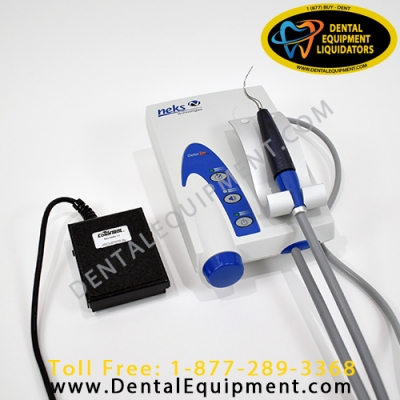Dental Calculus Detector from Neks Technologies *New*
Stock: 45
Clearance: Final Sale, No Returns Accepted
Detectar from Neks Technologies, is a tabletop electronic device that consists of a microprocessor-based power unit, electronic probe, and foot pedal.
Brand New System From Excess Stock
FREE SHIPPING
HOW IT WORKS:
The DetecTar is used like a conventional periodontal probe, using a 10°-15° angulation with slow vertical sweeping strokes along the root surface. The diameter of the DetecTar probe is the same (0.45 mm) as that of a conventional probe, allowing the clinician to perform the examination as usual. In the presence of subgingival dental calculus, the unit beeps and flashes a small green light.
This device is based on the ability to identify the characteristic optical signal of dental calculus. This new technology was not possible until very recently and relies on the latest development of light emitting diodes (LEDs) and the possibility of manufacturing LEDs of extremely narrow wavelength bands (20-40 nanometers). Dental calculus demonstrates a specific spectral signature (absorption, reflection, and diffraction of calcified structures are like finger prints) when illuminated with a specific selection of wavelengths. This spectral signature is different from that of other healthy structures such as dentin, cementum, soft tissues, subgingival fluids, and blood. The spectral signature of calculus remains constant for all subgingival calculus deposits. It is not affected by thickness (thin veneers or large ledges), surface quality (burnished or uninstrumented), or various degrees of mineralization.
An LED light is shined from the tip of the probe. The light returned off the root surface is picked up by a fiber optic lead and converted into an electrical signal for analysis. A computer-processed algorithm determines whether the probe is in contact with dental calculus and activates both an auditory and light signal to notify the clinician of the presence of the calculus.
DAILY APPLICATION
The advent of an objective method of detecting calculus provides us with a new dimension in periodontal therapy. Ultrasonic debridement to completely remove accretions such as plaque and calculus without removing root substance 5,15 in conjunction with the DetecTar to accurately identify the presence and location of residual subgingival deposits and the use of specific targeted hand instrumentation with curets will provide a more effective and conservative method of treatment.
In daily clinical practice, the DetecTar can be used in several ways:
1. Patient motivation. The auditory signal seems to have a profound effect on the patient during the examination. The patient can now “hear” the presence of periodontal disease and, as a result, explaining scaling and root planing procedures becomes easier.
2. Treatment time allocation. The time needed for future debridement appointments can be accurately planned depending on the general location and quantity of calculus assessed at the time of examination. This was difficult to assess previously, since accuracy at detecting calculus was inadequate.
3. Verification phase. After an initial debridement with ultrasonics to remove maximum plaque and hard deposits, the DetecTar can be used to identify residual subgingival calculus, thus allowing the practitioner to focus treatment on specific areas. This results in the reduction of root surface damage from nonspecific scaling and root planning and in a predictable end point for treatment.
4. Time efficiency. The learning curve to use the DetecTar is quick and easily achieved. Having an objective way to assess end point for therapy means less tendency to continue instrumentation of root surfaces after they are already clean. This not only saves time but also diminishes biological cost as less over-instrumentation should take place.
Complete Systems Consists Of:
1 microprocessor-based power unit
1 electronic probe
1 foot pedal
1 power cord
1 maintenance/calibration kit
1 instructional CD
1 operators instruction booklet


